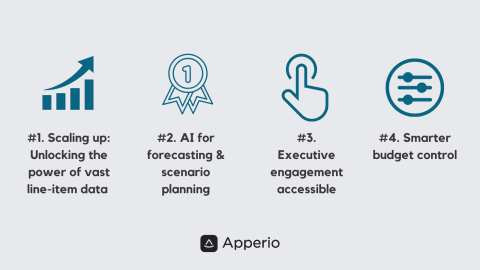Understanding legal spend data: How GenAI makes financial data more valuable

Legal and finance teams have more billing data than ever, but accessing the right insights at the right time remains a challenge. Reports take time to compile, key trends are buried in line-item details, and by the time issues are flagged, it’s often too late to intervene.
GenAI is changing this.
New technology allows teams to interact with legal spend data whilst the matter is still in progress—without depending on static reports or manual analysis. Instead of waiting for finance teams to surface insights, legal leaders can now ask questions like "Which matters are trending over budget?" or "How does our WIP (accruals) compare to last quarter?" and receive instant, data-backed answers.
But faster responses are just the start. AI-powered analytics identifies potential risks, forecasts spending trends, and tailors insights to different stakeholders—helping firms move from reactive cost management to proactive decision-making, accessible to all. Here's how...
How to better understand your legal spend data
Getting insights from legal spend data has always been challenging, even though the data is there. Traditional approaches involve static dashboards, manual data analysis, and waiting for finance teams to run reports—all of which slow down decision-making and create unnecessary delays.
GenAI offers a simpler approach.
With new GenAI technologies, teams can now have direct conversations with their data using everyday language. Instead of digging through reports or waiting for custom queries, legal and finance teams can ask straightforward questions like:
- “Which matters are at risk of exceeding budget?”
- “How does our external spend compare to last quarter?”
- “Where have we seen unexpected increases in WIP?”
The system processes these questions immediately and provides precise, data-backed answers—no technical expertise is required.
Teams can also dig deeper into specific issues by asking follow-up questions:
- “Why is this matter exceeding budget?”
- “Which fee earners contributed most to the increase?”
- “Are there similar patterns in other matters?”
This real-time access to legal spend data means teams can spot trends, identify risks, and manage costs more effectively—without waiting for end-of-month reports, and with no data science skills required.
Let’s look at how GenAI works in practice. ⬇
Use case #1.🔍 Scaling up: Unlocking the power of vast line-item data
Legal spend data is detailed—down to individual time entries, fee earner rates, and task-specific narratives. While this level of granularity is valuable, making sense of it at scale has traditionally been a challenge.
The result? Most legal and finance teams rely on summary reports and aggregated figures to track spend. But this approach often hides the real drivers of cost increases because the raw line-item data is too complex and time-consuming to analyse manually.
GenAI removes this barrier.
New solutions enable teams to analyze detailed billing data in seconds, converting complex information into clear, actionable insights. Rather than being limited to pre-made reports, teams can now ask specific questions like:
- “Break down WIP by practice area and fee earner for the last six months.”
- “Which matters have seen the biggest increase in hours booked last week?”
- “What is the total write-down for last year broken down month by month as a percentage?”
Because these queries access the data directly in real time, teams can explore specific trends, identify inefficiencies, and take action immediately—no more waiting for month-end reports.
Use case #2.🔍 AI for forecasting & scenario planning: Spot issues before they happen
Understanding current spending is important, but legal and finance teams need to look ahead to make better decisions.
With AI-driven forecasting and pattern detection, Gen AI technologies help teams identify spending trends before they become issues. Teams can:
- ✅️Spot potential budget overruns early through automated warning signals
- ✅️Create more accurate forecasts using historical patterns and real-time WIP data
- ✅️Test different scenarios to understand potential budget impacts
For example, users can ask:
- “How much are we projected to spend on external counsel next quarter?”
- “What impact would a 10% increase in litigation costs have on our total legal budget?”
- “Which matters are most likely to exceed their forecasted budgets?”
Moving from static budgeting to AI-driven forecasting helps organizations manage legal costs more effectively, without needing constant manual monitoring.
Use case #3.🔍 Executive engagement: Making legal spend data more accessible
Executives need legal spend data to make decisions, but they often struggle to get the information they need in a format that's immediately useful.
New technology solves this by tailoring information to each stakeholder's needs through:
- ✅ Natural language queries—so leadership can simply ask, “Where are we seeing unexpected spend growth?” and get clear answers.
- ✅ Custom views—so CFOs, GCs, and finance leads can access relevant insights.
- ✅ AI-powered summaries—so key takeaways are surfaced instantly, without needing to sift through detailed reports.
This becomes particularly valuable in time-sensitive situations. For instance, when external counsel costs start rising unexpectedly, the system can alert decision-makers before the next invoice arrives. This gives them time to redistribute work, adjust budgets, negotiate rates, or consider Alternative Fee Arrangements.
The result is that executives can now actively participate in managing legal spend without needing deep expertise in finance or legal operations. They get the insights they need, when they need them, in a format that makes sense for their role.
Use case #4.🔍 Smarter budget control: Tracking and flagging issues before they escalate
Managing legal budgets has become more complex than simply monitoring invoices or estimated accruals from law firms. AI technology helps teams stay ahead by:
- ✅️Ensure accruals are properly captured using real booking data, not estimates, so finance teams aren’t caught off guard.
- ✅️Identify trends in overspending, making it easier to anticipate future costs.
- ✅️Highlight areas where savings could be made, such as reallocating work to lower-cost fee earners, AFAs.
This proactive approach makes a real difference in day-to-day operations. When litigation costs start climbing faster than anticipated, the system can alert both the GC and CFO immediately. This gives them time to evaluate their options - whether that's putting spending caps in place, discussing rates with counsel, or redistributing workload.
The benefits extend to compliance teams too, as the AI can detect unusual billing patterns that might signal errors or incorrect allocations.
And by combining automated tracking with forward-looking insights, GenAI helps legal and finance teams maintain better control over spending without requiring constant manual monitoring.

A smarter and proactive way to manage legal spend data
Managing legal spend has always been a balancing act—tracking costs, forecasting budgets, and ensuring legal teams have the resources they need without overspending. But traditional methods rely too much on manual reporting, slow data access—often only invoice data, and reactive decision-making.
And that’s where GenAI shines. By combining conversational analytics, real-time budget tracking, and AI-driven forecasting, leading technology, like Apperio, is making legal spend management faster, smarter, and more proactive.
For legal and finance leaders looking to move beyond static reporting and make data-driven decisions in real-time, GenAI offers a way forward—one that replaces guesswork with confidence, inefficiency with automation, and reactive cost control with true spend intelligence.
Security considerations
Whilst there is great excitement about AI and the transformational power it offers, there is still concern about how it uses data to ensure it is safe and compliant.
Most customers are concerned about their data being:
- Moved between data centres, even if secure
- Training AI models with their highly confidential data
- Other customers who could be competitors benefiting from their data
- Data security, data being accessed or viewed by the right people
Despite these challenges there are solutions that overcome these concerns. Some GenAI solutions:
✅️No data replication
The very best solutions do not replicate data outside of the governed system. Generative AI operates in separation from the data, creating SQL scripts for the data-owning system but never touching the live data.
✅️Integration only with trusted data sources
They ensure generative AI operates directly on trusted and governed data sources, eliminating the risks associated with pulling unverified or external data into the process.
✅️Role-Based Access Control (RBAC)
They enforce role-based access controls, ensuring only authorized users can access certain data. This limits exposure to sensitive information.
✅️Real-time audit logs
They provide transparency and accountability by maintaining logs of all user interactions. These logs make it easier to detect and address unusual or unauthorized activities.
✅️Data residency and governance compliance
They respect data residency requirements and integrate with customers’ existing governance frameworks, ensuring data doesn't leave secure environments.
✅️Built-in security protocols
Adhere to industry standards for encryption, both in transit and at rest, ensuring the data remains protected throughout its lifecycle.
✅️Transparency in AI models
They ensure that generative AI outputs are explainable, reducing the risk of untraceable or biased decision-making.
Keen to learn how Apperio AI can help? Book a demo here today, and see for yourself how continuous legal spend tracking can make all the difference for 2025.